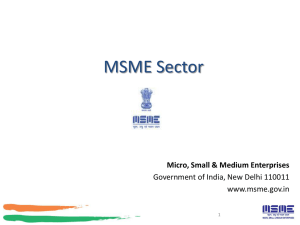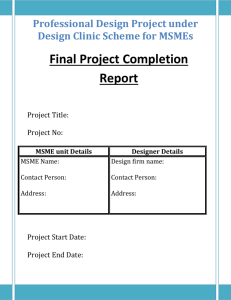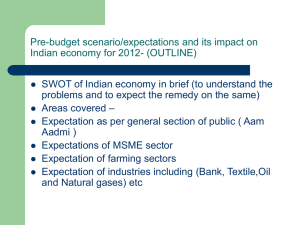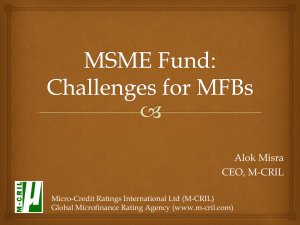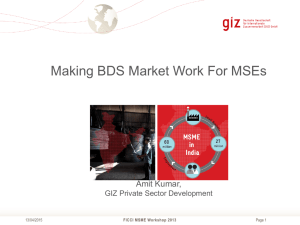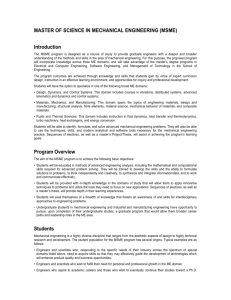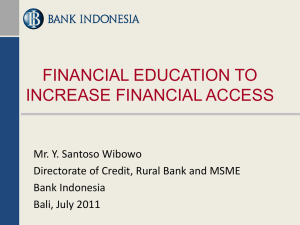A Policy-Cum-Perception Analysis on the Economic Reform Program: ‘Make in... Mediterranean Journal of Social Sciences Subhashree Natarajan MCSER Publishing, Rome-Italy
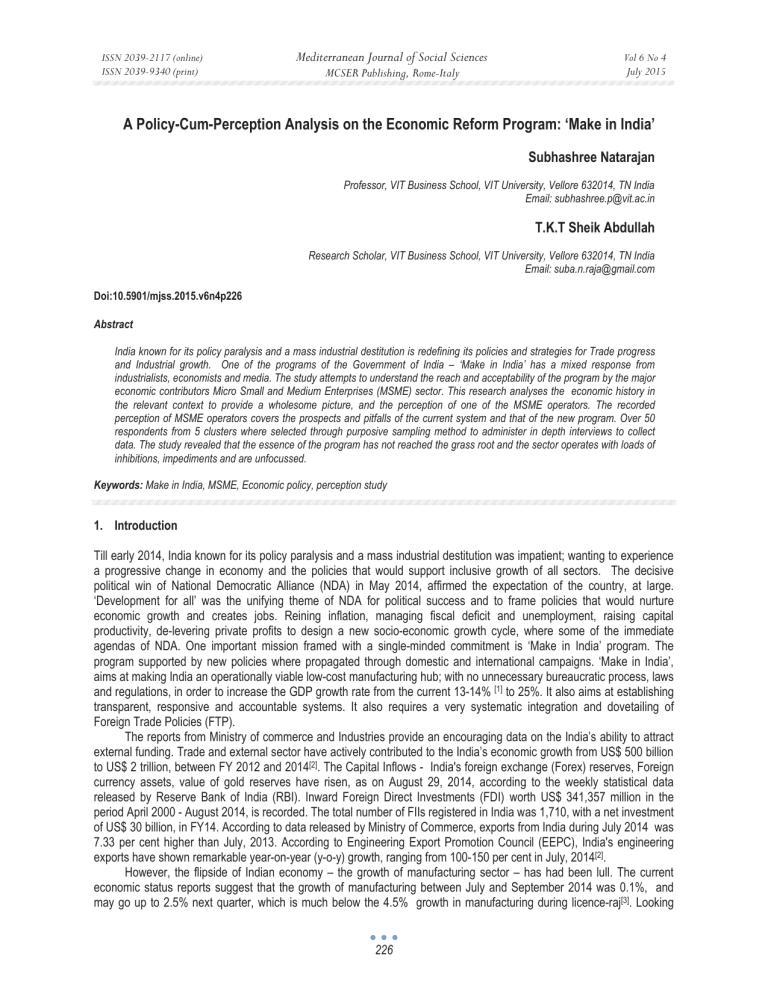
ISSN 2039-2117 (online)
ISSN 2039-9340 (print)
Mediterranean Journal of Social Sciences
MCSER Publishing, Rome-Italy
Vol 6 No 4
July 2015
A Policy-Cum-Perception Analysis on the Economic Reform Program: ‘Make in India’
Subhashree Natarajan
Professor, VIT Business School, VIT University, Vellore 632014, TN India
Email: subhashree.p@vit.ac.in
T.K.T Sheik Abdullah
Research Scholar, VIT Business School, VIT University, Vellore 632014, TN India
Email: suba.n.raja@gmail.com
Doi:10.5901/mjss.2015.v6n4p226
Abstract
India known for its policy paralysis and a mass industrial destitution is redefining its policies and strategies for Trade progress and Industrial growth. One of the programs of the Government of India – ‘Make in India’ has a mixed response from industrialists, economists and media. The study attempts to understand the reach and acceptability of the program by the major economic contributors Micro Small and Medium Enterprises (MSME) sector. This research analyses the economic history in the relevant context to provide a wholesome picture, and the perception of one of the MSME operators. The recorded perception of MSME operators covers the prospects and pitfalls of the current system and that of the new program. Over 50 respondents from 5 clusters where selected through purposive sampling method to administer in depth interviews to collect data. The study revealed that the essence of the program has not reached the grass root and the sector operates with loads of inhibitions, impediments and are unfocussed.
Keywords: Make in India, MSME, Economic policy, perception study
1.
Introduction
Till early 2014, India known for its policy paralysis and a mass industrial destitution was impatient; wanting to experience a progressive change in economy and the policies that would support inclusive growth of all sectors. The decisive political win of National Democratic Alliance (NDA) in May 2014, affirmed the expectation of the country, at large.
‘Development for all’ was the unifying theme of NDA for political success and to frame policies that would nurture economic growth and creates jobs. Reining inflation, managing fiscal deficit and unemployment, raising capital productivity, de-levering private profits to design a new socio-economic growth cycle, where some of the immediate agendas of NDA. One important mission framed with a single-minded commitment is ‘Make in India’ program. The program supported by new policies where propagated through domestic and international campaigns. ‘Make in India’, aims at making India an operationally viable low-cost manufacturing hub; with no unnecessary bureaucratic process, laws and regulations, in order to increase the GDP growth rate from the current 13-14% [1] to 25%. It also aims at establishing transparent, responsive and accountable systems. It also requires a very systematic integration and dovetailing of
Foreign Trade Policies (FTP).
The reports from Ministry of commerce and Industries provide an encouraging data on the India’s ability to attract external funding. Trade and external sector have actively contributed to the India’s economic growth from US$ 500 billion to US$ 2 trillion, between FY 2012 and 2014 [2] . The Capital Inflows - India's foreign exchange (Forex) reserves, Foreign currency assets, value of gold reserves have risen, as on August 29, 2014, according to the weekly statistical data released by Reserve Bank of India (RBI). Inward Foreign Direct Investments (FDI) worth US$ 341,357 million in the period April 2000 - August 2014, is recorded. The total number of FIIs registered in India was 1,710, with a net investment of US$ 30 billion, in FY14. According to data released by Ministry of Commerce, exports from India during July 2014 was
7.33 per cent higher than July, 2013. According to Engineering Export Promotion Council (EEPC), India's engineering exports have shown remarkable year-on-year (y-o-y) growth, ranging from 100-150 per cent in July, 2014 [2] .
However, the flipside of Indian economy – the growth of manufacturing sector – has had been lull. The current economic status reports suggest that the growth of manufacturing between July and September 2014 was 0.1%, and may go up to 2.5% next quarter, which is much below the 4.5% growth in manufacturing during licence-raj [3] . Looking
226
ISSN 2039-2117 (online)
ISSN 2039-9340 (print)
Mediterranean Journal of Social Sciences
MCSER Publishing, Rome-Italy
Vol 6 No 4
July 2015 back at Indian economic history, in the absence of conducive manufacturing environment - tax breaks and subsidies provided to SEZs will have a crunch; the government would force public sectors to purchase from MSMEs to an extent of
20% or more and an import substitution approach may be adopted. The MSME quotas and import substitution approaches are a big fallacies of India in yesteryears and does not glue well with Modi’s ‘Minimum government and maximum governance’ promise.
The big bottle-necks of India are Infrastructure, power/electricity, slow growth in financial and banking sector and a failed public-private partnership models that nurture employability and employee security. The World Bank and IFC s’
Doing Business Report -2015 places India at the lowest ranks – 142 of 189 countries surveyed. The report indicates that
India holds 121 st rank in registering property, 122 nd with regard to friendly FTP, 134 th for getting electricity connections,
137 th in resolving insolvency states, 156 th for tax payments, 184 th in getting construction permits, and 186 th in enforcing contracts [4] . Most of the above mentioned issues are under the jurisdiction of State Governments, no which the Central
Government cannot impose any tough reforms.
2.
Research Methodology
Need for research: India is one of the most prominent forces within the world economy. The research on emerging policies, trends and governance of the same needs minute introspection to avoid policy failures. Make in India is a new program designed to facilitate economic growth of India; However, the inhibitions at the grass-root level need to be understood as the policy evolves, in order to popularize and prevent fallacies. This study is comprehensive in understanding the past, the present policy and the perception towards the new policy derived both from its own principles and past experiences.
Research Objective: The objective of the study is to understand and evaluate their awareness level, their expectations and the mental impasse on the industrial theme ‘Make in India’.
Primary data source, sample design and characteristics: The descriptive study employs purposive sampling method to draw a sample of 50 respondents; 10 from each of the five leading industries of MSME Manufacturing sector, in Tamilnadu, India were the study was conducted. Indepth interviews using interview guides were conducted to elucidate the perception of the respondents. The interview had a three parts. One, to understand the current difficulties of MSME units and two, the clarity and awareness level of the respondents on ‘Make in India’ industrial theme and three, their perception on the impact of the theme on their business.
Demographic data collected include broad activity, main products, year of establishment and type of unit, ownership and operation. Vital statistics on organization data and the prospects and problems in business is collected. It includes all functional status of the unit; like, financial details ranging from source of funds for working capital to turnover of the unit. The awareness level of the respondents is recorded by evaluating the respondent’s clarity in explaining the
Make in India program, its objectives, government support and their’ ability to correlate logically with their future business prospects.
Attributes and variables: Seventeen attributes are evaluated using a multidimensional scale, ranging from unfavourable to favourable degree of response, on a 5 point scale.
Description on the sample frame and geographical validity: The five industrial clusters were chosen based on their ability generate employment, state level leadership and / or their stature as a leader/follower in international business.
The five clusters include Leather and leather products, Chemicals, food products, transport and non-transport machinery and equipments and textiles. Tamilnadu ranks as the third best state in India in promoting MSME evident from the number of working enterprises, employment in MSME, and second best in capital accumulation. The number of MSME working enterprises in Tamilnadu represents over 15 percent of total units in India; and, has grown from 25,794 units with the total investment of Rs.722.16 crore in 2003-04 to 83,348 enterprises with Rs.8,751.54 crores in Feb 2014 [5] . A total of
103 clusters operate in Tamilnadu [6] . The state has a mix of job-less growth and high growth labour-intense clusters. It is expected that the survey within the geographical limits of Tamilnadu would represent a balanced and a comprehensive view of the MSME promoters
Secondary data sources : The data on macroeconomic indicators and its components are collected from various published reports of RBI, Ministry of Finance Department of Economic Affair, SDDS & NSDP, CSO, NSSO, World Bank and IFC and MSME
Chapterisation:
The premise of the study (ie., analysis) is organized in 4 sections, in the order given below
1.
To gain a macro view on the current economical and industrial stature of MSME Manufacturing sector
2.
To spell out the objectives of ‘Make of India’ clearly, for the benefit of the readers
227
ISSN 2039-2117 (online)
ISSN 2039-9340 (print)
Mediterranean Journal of Social Sciences
MCSER Publishing, Rome-Italy
Vol 6 No 4
July 2015
3.
To study the perception of MSME Manufacturing unit promoters towards ‘Make in India’
4.
Infer the data for understanding the expectations and perceptions of the respondents for suggesting the action
3.
Analysis
3.1
Macro-view of MSME manufacturing sector:
The official records of MSME states there is a decline in the growth rate of Manufacturing sector of MSME with regard to estimated number of working enterprises and employment between 2001-02 and 2006-07, from 15.30 percent to 15.02 percent; while MSME as a complete sector witnessed a decline from 28.02 percent to 26.43 percent with reference to the same factors, during the same period [7] . The percentage of share of MSME’s manufacturing sector towards GDP has also been consistently declining, from 7.81 percent in 2007-08 to 7.28 percent in 2011-12. (refer table- 02)
Table 1: Contribution of manufacturing output of MSME in GDP (at 2004-05 prices) [8]
Year Gross Value of Output (Rs. in Crore)
2006-07 1198817.55
2007-08 1322960.41
2008-09 1375698.60
2009-10 1488390.23
Percentage Share of MSME
Total Manufacturing output Gross Domestic Output (GDP)
42.02
41.98
40.79
39.63
7.73
7.81
7.52
7.49
2010-11 1655580.60
2011-12* 1790804.67
38.48
37.52
7.42
7.28
Note: * - Provisional.
Source: 1. Fourth All India Census of MSMEs 2006-07, 2. National Account Statistics 2013, CSO, M/O SPI and 3. Annual Survey of Industries, CSO, M/O SPI
A closer analysis on some of the data provided by RBI and MSME – enclosed as the table -2 provides important insights on growth in employment, capital asset productivity depicted in the figures. The analysis indicates that the average employment generated by a working enterprise is well below the early stages of globalization; it declined from 2006-07
(2.39 lakhs) with negligible increase over years (stands at 2.26), despite considering the most powerful sector unregistered MSME segment [9] . It reaffirms the growth of non-labour intense units. Secondly, though the capital accumulation has consistently increased, the output from the capital accumulated is declining; which is an alarm on the economy multiplier, productivity, consumption based growth and a balanced sectoral and regional development. Thirdly, from the published reports of the Planning Commission and RBI, the employment elasticity in 2009-10 was as low as
0.01; which means that for every 1 percent point growth in GDP, the employment increases by just one basis point [10]
Table 2: A Timeline Analysis on Msme Performance [11]
(In Lakh)
2.41 152102.49 2.40
2005-06 123.42 294.91 18811300.00 49784200.00 2.39 15.24
2006-07 † * 361.76 805.23 86854379.00 135138345.00 2.23 24.01 1.56 167825.77 2.14 2854.88 125.44
Note: Column I to V where published by Ministry of MSME, India
† Including activities of wholesale/retail trade, legal, education & social services, hotel & restaurants, transports and storage & warehousing
(except cold storage) for which data were extracted Economic Census 2005, Central Statistics Office, M/o SPI.
* Estimated on the basis of per enterprises value obtained from sample survey of unregistered sector for activities wholesale/retail trade, legal, education & social services, hotel & restaurants, transports and storage & warehousing(except cold storage) which were excluded from Fourth
All India Census of MSME, unregistered sector # Projected
228
ISSN 2039-2117 (online)
ISSN 2039-9340 (print)
Mediterranean Journal of Social Sciences
MCSER Publishing, Rome-Italy
Vol 6 No 4
July 2015
3.2
Objectives of ‘Make in India’:
The frontline objective of ‘Make in India’ is to make India an attractive low-cost manufacturing hub that generates over 10 million employment for Indian workforce every year, and brings-in economic stability and growth to the targeted 25%.
The initially issued agenda includes a.
The campaign aims at transforming India from a service-based economy to a balanced employment generating labour-intense manufacturing and growth driven economy. b.
CEOs of India Inc, Foreign Industry leaders and the Ministry to work closely in identifying the growth propelled sectors in identified countries to propagate the theme. The domestic companies with proven leadership in innovation and new technologies in 25 key sectors to be given a boost to emerge as global champions c.
A draft a clear modus operandi for officials to engage with investors and consultants to push investments and create jobs d.
To extend an open-arm welcome to simplified industry-friendly, regulatory and clearance policies . Ministry of
Commerce, “India Invest” unit will act as a single reference point for the same.
The identified sectors include automobiles, chemicals, IT, pharmaceuticals, textiles, ports, aviation, leather, tourism and hospitality, wellness, railways among others will provide details of growth drivers, investment opportunities, sector specific FDI and other policies and related agencies.
The Government has assured that MSME is not ignored and that though MSME is not on the main-stream of the agenda, required deregulation policies, skill transformation mandate and the working committees are constituted to support the larger vision ‘Make in India’
3.3
Perception of MSME promoters on ‘Make in India’ theme:
The Seventeen attributes evaluated on a 5-point multidimensional scale, ranging from unfavourable to favourable degree of response revealed the existing impediments and leverage points of the MSME system. The list below represents the weighted average score of the foremost problems, in all the 5 clusters considered for the study, in the order of severity.
The table-3 is the weighted average score of the attributes, sectorwise.
Infrastructure, specially electricity
Increasing Labour productivity
Less of Pollution problems
Low Raw material cost
Low Labour cost
Availability of productive Technology
Easy availability of Skilled labour
Ease in availability of Finance/credit
Low cost of Training
Extended Government support
Table 3 Clusterwise Attribute Conduciveness
Criteria (Y axis) [12] / Cluster (X axis)
Availability of credit facility
High Labour productivity
Less of Pollution problems
Low Raw material cost
Low Labour cost
Availability of productive Technology
Easy availability of Skilled labour
Ease in availability of Finance/credit
Low cost of Training
1.50 1.30 1.80 1.40 1.35
2.00 1.40 2.40 1.60 1.30
2.00
1.70
2.10
1.40
2.30
3.70
2.10
0.00
1.60
1.40
1.90 3.50 1.70 2.00 1.50
1.80 2.70 2.60 2.10 1.60
1.90
3.40
2.50
2.90
3.00
2.30
2.50
4.00
2.70
3.70
3.00
3.70
0.00
2.20
2.30
2.30
1.70
2.00
3.30
1.70
Government 3.10 2.90 3.70 3.10 2.00
Conduciveness of Laws relating to Land 2.60 1.70 3.80 4.80 2.10
Easy availability of Labour
Increase in market demand
Ease in availability of Raw material
Ease in Marketing
2.00
3.40
2.70
2.20
3.30
3.20
3.70
3.40
3.70
4.40
3.70
3.70
3.40
1.40
2.90
4.00
2.80
3.00
3.60
3.70
1.47
1.74
2.02
2.05
2.12
2.16
2.33
2.72
2.72
2.92
2.96
3.00
3.04
3.08
3.32
3.40
Cluster weighted Average score 2.26 2.57 3.05 2.14 2.08
I -Leather and leather products, II- Chemicals, III - Food Products, IV - Transport and Non-transport machinery and equipments, V - Textiles
229
ISSN 2039-2117 (online)
ISSN 2039-9340 (print)
Mediterranean Journal of Social Sciences
MCSER Publishing, Rome-Italy
Vol 6 No 4
July 2015
The problem that varies with clusters and type of ownership is the huge demand for funds. It was also pointed out that some of the applications for trade credit are sanctioned based on face-value and good relation between the bankers and
MSME unit promoters. A transparent, credit based bank advances are welcomed.
Cluster-wise analysis indicates a positive perception of growing demand, increase in profits and employment amongst the MSME operators in food products cluster.
3.4
Awareness and knowledge level on ‘Make in India’:
All the respondents are aware of ‘Make in India’ program at the conceptual level; but they are not fully aware of the objectives, its implication, modus operandi and the benefits of the program. This has forced the researchers to explain the theme, its objectives and provide the web references to MSME operators. Fully conscious that the personal bias of the researchers would have influenced the respondents, the research was continued to record the benefits expected.
4.
Results and Discussions
4.1
Perception on Make in India:
Most of the respondents perceived that ‘Make in India’ is a program to attract FDI. The respondents described Make in
India as a central government program aimed at mobilizing foreign trade partners and investors of large scale sectors and that the direct beneficiaries are not MSME. They had difficulty in perceiving a link between MSME and Make in India program. The structural changes, revised policies and norms for MSME are not lucrative as the respondents felt that the system is not transparent to record all applications for government support and are at the discretion of the bank managers. Some of the respondents agreed that the technological and trade spill-overs may create new business opportunities. However, the opportunities cannot be translated to business proposition when there is a shortage of energy supplies and labour and rising costs.
To affirm the awareness level and perception of the respondents, the study posed a few specific questions on schemes for International cooperation and on schemes for market development and assistance. The MSME operators are completely unaware of the functional and operational dimensions of the schemes. The response score on the eligibility criteria, operational conditions, eligible items for participation, quantum of funds for both the schemes, were negligibly low.
4.2
Recommendations
As the constraining factors are the awareness and thus the lack of knowledge on the supportive schemes, the study recommends that the Ministry of MSME should design and broadcast Make in India- MSME objectives, supportive policies, expected outcomes and benefit, at the grass-root level. The communication should clearly enumerate the amendments that facilitate MSME operators in availing credit, in reaching international markets, in upgrading the outdated technology and the new provisions that nurture innovation.
The benefits of FDI, when properly used, in increasing the investment rate and total factor productivity attainable through technology transfer, exports, enhances human productivity and competitiveness should be clearly communicated. The communication will help in easing out the fear of foreign dominance in domestic market and steer the
MSME on a result-oriented growth.
The study also recommends that evaluation of MSME units should include employment generation, technological updation, and future scope for export, in addition to revenue generation, for extending additional support. Proper policies and frameworks to measure, facilitate, monitor and control MSME units and supporting bodies would enhance the productivity. This in the long-run will help in partnering large enterprises for cluster development.
Indian MSME is in dearth of new and productive technologies, that has retarded their growth. Make in India program, in coordination with Ministry of MSME may provide assistance in accessing relevant foreign technologies by networking with international MSME.
The expectation for a quicker, faster and transparent system for disseminating information, rule and regulations, application and advancement of and incentives etc can be achieved through e-governance mechanism. The current web sites that act as information dissemination boards can be made more functional for easy compliance
230
ISSN 2039-2117 (online)
ISSN 2039-9340 (print)
Mediterranean Journal of Social Sciences
MCSER Publishing, Rome-Italy
Vol 6 No 4
July 2015
4.3
Limitations
The prospects and problems of MSME differs with state and clusters. Existing prospects and conducive environment are not included for a few reasons like it varies with states; the objective of the research is to focus upon Make in India program and not to study the effectiveness of existing schemes and institutions.
A considerable degree of researchers’ bias in elucidating the opinion on Make in India program was inevitable, as the respondents were unaware of the programs fulcrum.
4.4
Conclusion
MSME plays a significant role in the economic growth of a country. Indian MSMEs produce a wide range of products and services - from a simple consumable to highly sophisticated industrial products; life-saving drugs, indigenous wellness packages, IT services, agro products and many more. It has maintained a higher growth rate despite increasing cost, international competition and global economic slowdown. A proper thrust, supportive policies and transparent systems will increase its competitiveness. Translating a paper policy into an actionable agenda at the grass-root has always been a problem in India. This study clearly indicated that the policies and benefits have not reached the MSME operators.
They are at large, operating with short-term focus, plagued with fear and distrust that the systems are unsupportive. The current perception may not kindle a progressive change at micro-organisational or at macro-MSME sector level.
Citation Index/References
Credit Scoring, Speech delivered by Dr. Deepali Pant Joshi, Executive Director, Reserve Bank of India at the launch of credit scoring model by
Canara Bank on May 8, 2014 at Mumbai
IBEF report on ‘Role of Manufacturing in employment generation in India’ 2014
Sangita Misra and Anoop K Suresh , ‘Estimating Employment Elasticity of Growth for the Indian Economy ‘, rbi.org.in
OECD Economic Surveys: India 2014, DOI:10.1787/eco_surveys-ind-2014-en
Micro, Small and Medium Enterprises Department Policy Note 2013 – 2014, Demand No.44, P. Mohan Minister for Rural Industries, Government of Tamil Nadu 2013
Annual Reports, Ministry of MSME, Government of India
‘Ministry of Micro, Small & Medium Enterprises, 2007: Micro, Small and Medium Enterprises in India: An Overview”, Ministry of Micro Small and
Medium Enterprise, Government of India
Final Results: Final Report of the 4 All India Census of MSME , 2006-07 : Registered Sector’, Edition 2011, Ministry of Small Scale Industries,
Government of India.
‘Summary Results & Comparison With Third All India Census Of SSIs 2001-02: Unregistered sector. (Fourth All India Census of MSME:
Unregistered Sector), Open Government data(OGD) platform, Development Commissioner (MSME) Government of India
Jessica Wade, ‘Micro, Small and Medium Enterprises Development Act – Background Paper’, Small Enterprise Finance Centre, IFMR
Statistical year book 2014, Ministry of Statistics and Program Implementation, Government of India
MSME Development Act 2006, Ministry of MSME, Government of India
References
Aditya Chopra, Devang Negandhi, Soumith Chintala, A Kannammal, N Ch Iyengar, V Ramachandran (2010) "Frame based Intelligent Tutoring
System with weighted attributes and adaptive hypermedia", International Journal of Electronic Business, vol.8, no.4, pp.342-359, pg:342-359
Annual Reports, Ministry of MSME, Government of India
Credit Scoring, Speech delivered by Dr. Deepali Pant Joshi, Executive Director, Reserve Bank of India at the launch of credit scoring model by
Canara Bank on May 8, 2014 at Mumbai
Final Results: Final Report of the 4 All India Census of MSME , 2006-07 : Registered Sector’, Edition 2011, Ministry of Small Scale Industries,
Government of India.
IBEF report on ‘Role of Manufacturing in employment generation in India’ 2014
Jessica Wade, ‘Micro, Small and Medium Enterprises Development Act – Background Paper’, Small Enterprise Finance Centre, IFMR.
Micro, Small and Medium Enterprises Department Policy Note 2013 – 2014, Demand No.44, P. Mohan Minister for Rural Industries, Government of Tamil Nadu 2013
‘Ministry of Micro, Small & Medium Enterprises, 2007: Micro, Small and Medium Enterprises in India: An Overview”, Ministry of Micro Small and
Medium Enterprise, Government of India
MSME Development Act 2006, Ministry of MSME, Government of India
OECD Economic Surveys: India 2014, DOI:10.1787/eco_surveys-ind-2014-en
Quarterly reports published by RBI, Government of India
Sangita Misra and Anoop K Suresh , ‘Estimating Employment Elasticity of Growth for the Indian Economy ‘, rbi.org.in
Statistical year book 2014, Ministry of Statistics and Program Implementation, Government of India
‘Summary Results & Comparison With Third All India Census Of SSIs 2001-02: Unregistered sector. (Fourth All India Census of MSME:
Unregistered Sector), Open Government data(OGD) platform, Development Commissioner (MSME) Government of India
231
